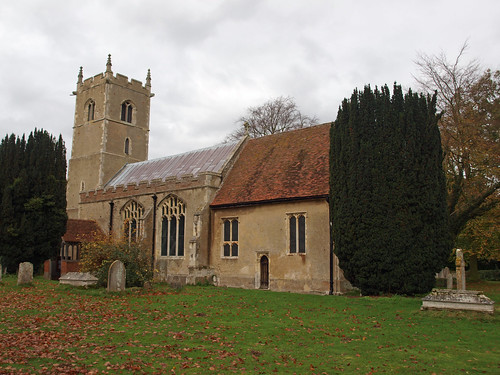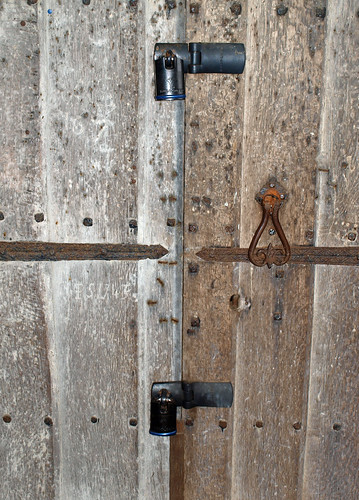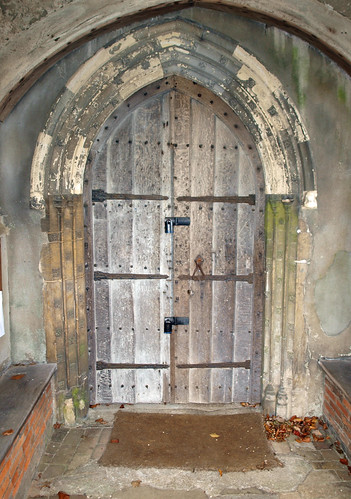There are keyholder phone numbers listed but, frankly, I couldn't be arsed to bother trying them, having recently come to the conclusion that listing phone numbers rather than addresses and directions for keyholders is almost as bad as not listing anything at all. Besides which the insensitive attachment of hasps and clasps to the ancient door indicated a distinctly cold welcome.
ALL SAINTS. The nave has Norman SW quoins; that is all that survives of the C12. Of the C13 the W tower, unbuttressed with some small lancet windows. The rest is Perp, with big three-light windows with panel tracery of usual patterns. The battlements oddly enough are of Roman bricks. Handsome C15 S porch; timber with traceried lights to the sides and a bargeboarded gable. C15 N arcade of three bays on thin piers with a section of four main shafts and four slimmer shafts without capitals in the diagonals. The arches (and also the chancel arch) are decorated with fleurons (cf. e.g. St Peter, Sudbury across the Suffolk border). Hood-moulds with head-stops. Roof on big head corbels. - PULPIT. Elizabethan, with arched as well as moulded panels. - FONT COVER. Of tall, pinnacled Gothic form (cf. Sudbury) but mostly C19.
Just before the Roman road dips to cross the Stour into Suffolk is a splendid church, in company with a cricket green, many fir trees, and a rectory almost hidden by a magnificent cedar. Roman bricks form a corner of the nave; and still left from Norman days, are a window above the tower arch and a rare pillar piscina with a scalloped capital. Nearly all the building, however, is 14th and 15th century - the fine tower with animal heads including an open-mouthed goat, the roofs with some of their old timbers and a wooden figure holding a shield, the porch enriched with lovely tracery and sheltering a 500-year-old door with ironwork looking even older.
Master craftsmen in stone must have been here in those medieval days, their skill showing in many dainty heads outside the windows, floral designs on the south doorway, shields with bells and chalices on the arcade, and a little carving we liked of a lady in a 15th century hat. Scratched on one of the nave buttresses is a sundial.
The chancel has linen-fold panelling and a chair carved in the 17th century. Just as old are a table in the chapel, and a splendid pulpit with arches and vines and a handsome wooden pillar for the parson to hold as he climbs in.
A tablet to a soldier in the South African War has an epitaph from Shakespeare, as short and fitting a memorial as a warrior could have. It comes from Macbeth:
Siward. Had he his hurts before?
R0ss. Ay, on the front.
Siward. Why, then, G0d’s soldier be he!
Simon K -
Next, it was across the A134 to Great Horkesley. On the map, this appears remote from the road behind a vast greenhouse, but there is a little sliproad to it almost immediately on leaving the A134. The car park was full of a shooting party which had just ended, about 40 people, drinking beer and whiskey as their spoils were divided by beaters and gamekeepers. I'm always pleased that little bits of old England survive like this, but they weren't terribly friendly when I smiled and said hello, I fear. Perhaps they thought that, being on a bike, I was some Green Vegetarian Animal Rights protester. Be that as it may, I threaded through them to the church.
Open, but there was a churchwarden inside. He told me that the church is normally kept locked ('it's so remote' - not as remote as Langham, I wanted to say). There is a keyholder notice, and he said he was always happy to come out and open up for anyone who wanted to see inside. I'm sure this was true, he was very nice. It seems odd to find a locked church out here, but Great Horkesely is in the same benefice as West Bergholt (the new church there, that is - the old one is CCT and open) and Fordham, both of which I had also found locked.
The north arcade is extraordinary, intricately carved with fleurons, crowns and ladies heads. Otherwise, a rather shabby 19th Century interior I fear, which I quite liked in a way, it was rather endearing.
The big surprise was finding a memorial to Lieutenant Arthur Page of the Suffolk Regiment, whom I had previously read lots about, but had forgotten he was from here. He was killed at Longueval in the Battle of the Somme on 19th August 1916. What makes him significant to me is that my great Grandfather was also called Arthur Page, was a Sergeant in the Suffolk Regiment, and was killed in the same place the following day. In research I have found the two often confused, and even conflated, and have had to disentangle them from each other. It was odd to come across him again in a different context.
The exterior is quite interesting, with lots of puddingstone used in the construction.
Flickr set.




Exactly how I found it today. Not quite as bad as Feering, but not far off.
ReplyDelete